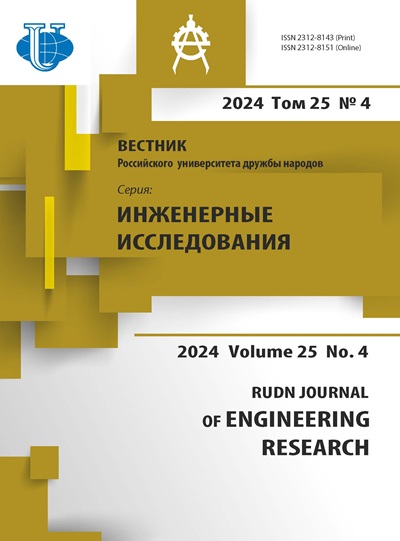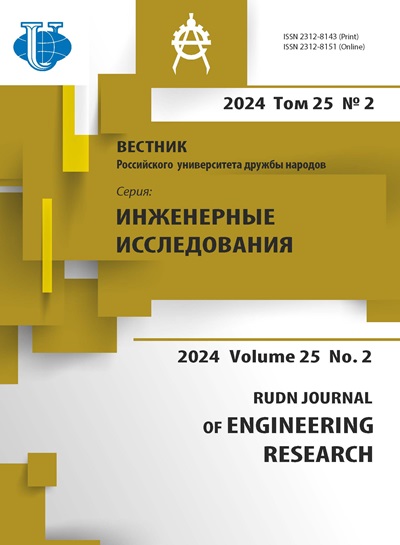Техническое решение по снижению эффекта кавитации в лопатке турбины Каплана
- Авторы: Халид М.Р.1, Реза Каши Заде К.1, Горбани С.1
-
Учреждения:
- Российский университет дружбы народов
- Выпуск: Том 25, № 2 (2024)
- Страницы: 121-129
- Раздел: Статьи
- URL: https://journals.rudn.ru/engineering-researches/article/view/40357
- DOI: https://doi.org/10.22363/2312-8143-2024-25-2-121-129
- EDN: https://elibrary.ru/HWEUSZ
Цитировать
Полный текст
Аннотация
Применение турбин Каплана широко распространено на гидроэлектростанциях малой и большой мощности. Понимание механизмов отказа указанных турбин является ключевым фактором для разработки решений по их предотвращению или своевременному устранению, а также для обеспечения их работоспособности. Надежная работа турбин Каплана зависит от многих факторов, таких как кавитация, эрозия, усталость и дефекты материалов. Кавитация в турбинах Каплана приводит к нестабильности потока, вибрациям, повреждению поверхности и снижению производительности машины. В связи с этим исследованы факторы, приводящие к кавитации в турбине Каплана, и представлены практические решения данной проблемы. Покрытия, нанесенные термонапылением, часто применяются из-за их высокой износостойкости, экономической эффективности, снижения веса и меньшего негативного воздействия на основной металл. Кроме того, высокоскоростное распыление кислородного топлива (HVOF) используется для создания покрытий с высокой плотностью и прочностью сцепления. При высоких температурах металлокерамические покрытия, в том числе наночастицы, обладают исключительной износостойкостью. Наноструктурированные и многогранные покрытия на основе WC используются из-за их высокой износостойкости. Кроме того, карбид хрома в покрытиях на основе WC повышает их стойкость к окислению и износу.
Ключевые слова
Об авторах
Мохаммед Рида Валид Халид
Российский университет дружбы народов
Email: 1042218144@rudn.ru
ORCID iD: 0009-0009-0798-4317
аспирант базовой кафедры машиностроительных технологий, инженерная академия
Москва, РоссияКазем Реза Каши Заде
Российский университет дружбы народов
Email: reza-kashi-zade-ka@rudn.ru
ORCID iD: 0000-0003-0552-9950
кандидат технических наук, профессор департамента транспорта, инженерная академия
Москва, РоссияСиамак Горбани
Российский университет дружбы народов
Автор, ответственный за переписку.
Email: gorbani-s@rudn.ru
ORCID iD: 0000-0003-0251-3144
SPIN-код: 8272-2337
кандидат технических наук, доцент базовой кафедры машиностроительных технологий, инженерная академия
Москва, РоссияСписок литературы
- Gordon JL. Hydraulic turbine efficiency. Canadian Journal of Civil Engineering. 2001;28(2):238-253. https://doi.org/10.1139/l00-10
- Fahmi ATWK, Kashyzadeh KR, Ghorbani S. A comprehensive review on mechanical failures cause vibration in the gas turbine of combined cycle power plants. Engineering Failure Analysis. 2022:106094. https://doi.org/10.1016/j.engfailanal.2022.106094
- Kashyzadeh KR, Kivi SA, Rynkovskaya M. Fatigue life assessment of unidirectional fibrous composite centrifugal compressor impeller blades based on FEA. International Journal of Emerging Technology and Advanced Engineering. 2016;7:6-11.
- Amiri N, Shaterabadi M, Reza Kashyzadeh K, Chizari M. A comprehensive review on design, monitoring, and failure in fixed offshore platforms. Journal of Marine Science and Engineering. 2021;9(12):1349. https://doi.org/10.3390/jmse9121349
- Rus T, Dular M, Širok B, Hočevar M, Kern I. An Investigation of the Relationship Between Acoustic Emission, Vibration, Noise, and Cavitation Structures on a Kaplan Turbine. Journal of Fluids Engineering. 2007; 129(9):1112-1122. https://doi.org/10.1115/1.2754313
- Cencîc T, Hocevar M, Sirok B. Study of Erosive Cavitation Detection in Pump Mode of Pump-Storage Hydropower Plant Prototype. Journal of Fluids Engineering. 2014;136(5):051301. https://doi.org/10.1115/1.4026476
- Xavier E, Eduard E, Mohamed F, Francois A., Miguel C. Detection of cavitation in hydraulic turbines. Mechanical Systems and Signal Processing. 2006;20(4): 983-1007. https://doi.org/10.1016/j.ymssp.2004.08.006
- Duraiselvam M, Galun R, Wesling V, Mordike BL, Reiter R, Oligmuller J. Cavitation erosion resistance of AISI 420 martensitic stainless steel laser-clad with nickel aluminide intermetallic composites and matrix composites with TiC reinforcement. Surface and Coatings Technology. 2006;201(3-4):1289-1295. https://doi.org/10.1016/j.surfcoat.2006.01.054
- Farrahi GH, Chamani M, Kashyzadeh KR, Mostafazade A, Mahmoudi AH, Afshin H. Failure analysis of bolt connections in fired heater of a petrochemical unit. Engineering Failure Analysis 2018;92:327-342. https://doi.org/10.1016/j.engfailanal.2018.06.004
- Ming Z, David V, Carme V, Mònica E, Eduard E. Failure investigation of a Kaplan turbine blade. Engineering Failure Analysis 2019;97:690-700. https://doi.org/10.1016/j.engfailanal.2019.01.056
- Kumar P, Saini RP. Study of cavitation in hydro turbines - A review. Renewable and Sustainable Energy Reviews. 2010;14(1):374-383. https://doi.org/10.1016/j.rser.2009.07.024
- Farhat M, Bourdon P, Gagné JL, Remillard L. Improving hydro turbine profitability by monitoring cavitation aggressiveness. CEA Electricity ‘99 Conference and Exposition. Vancouver, March. 1999. p. 1-15.
- Karimi A, Avellan F. Comparison of erosion mechanisms in different types of cavitation. Wear. 1986; 113(3):305-322. https://doi.org/10.1016/0043-1648(86) 90031-1
- Shi H, Li Z, Bi Y. An On-line Cavitation Monitoring System for Large Kaplan Turbines. 2007 IEEE Power Engineering Society General Meeting. Tampa, FL, USA; 2007. https://doi.org/10.1109/PES.2007.385723
- Alligne S, Nicolet C, Allenbach P, Kawkabani B, Simond JJ, Avellan F. Influence of the vortex rope location of a Francis turbine on the hydraulic system stability. Proceedings of the 24th Symposium on Hydraulic Machinery and Systems, Foz do Iguassu, Brazil, October 27-31, 2008. http://doi.org/10.5293/IJFMS.2009.2.4.286
- Mohammad DA, Frengki MF. Cavitation Analysis of Kaplan-Series Propeller: Effect of Pitch Ratio and nProp using CFD. International Journal of Marine Engineering Innovation and Research. 2021;6(2): 114-124. http://doi.org/10.12962/j25481479.v6i2.8747
- White FM, Majdalani J. Viscous Fluid Flow. 4th ed. New York, NY: McGraw-Hill Education; 2021. 2021. 18. Brennen CE. Cavitation and bubble dynamics. UK: Cambridge University Press; 2013.
- Higuchi H, Arndt REA, Rogers MF. Characteristics of Tip Vortex Cavitation Noise. Journal of Fluids Engineering. 1989;111(4):495-501. https://doi.org/10.1115/1.3243674
- Chang N,Ganesh H, Yakushiji R, Ceccio SL. Tip Vortex Cavitation Suppression by Active Mass Injection. Journal of Fluids Engineering. 2011;133(11):111301. https://doi.org/10.1115/1.4005138
- Mohamed F, Francois A. On the detachment of a leading edge cavitation. Laboratory For Hydraulic Machines Swiss Federal Institute of Technology EPFLIMHEF-LMH. Av. De Cour, 33 CH-1006 Lausanne, Switzerland. 2014. Available from: https://caltechconf.library.caltech.edu/130/ (accessed: 02.05.2023)
- Sezen S, Atlar M. Mitigation of Hub Vortex Cavitation with Application of Roughness. Journal of Marine Science and Engineering. 2022;10:1426. https://doi.org/10.3390/jmse10101426
- Ghassemi H, Mardan A, Ardeshir A. Numerical analysis of hub effect on hydrodynamic performance of propellers with inclusion of pbcf to equalize the induced velocity. Polish Maritime Research. 2012;19:17-24. https://doi.org/10.2478/v10012-012-0010-x
- Jani DB, Mistry Y, Suthar M, Suthar A, Shah J, Patel P. An overview on cavitation in centrifugal pump. International Journal of Innovative Research in Technology. 2019;6(5):1-5.
- Pohl M, Stella J. Quantitative CLSM roughness study on early cavitation-erosion damage. Wear. 2002; 252(5-6):501-511. https://doi.org/10.1016/S0043-1648 (02)00003-0
- Leith WC. Cavitation damage of metals. Doctoral thesis. McGill University, Department of Mechanical Engineering; 1960.
- Mathias M, Göcke A, Pohl M. The residual stress, texture and surface changes in steel induced by cavitation. Wear. 1991;150(1-2):11-20. https://doi.org/ 10.1016/0043-1648(91)90302-B
- Ermolieff A, Amouroux A, Marthon S, Faviet JF, Peccoud L. XPS studies of contamination of reactor and silicon surfaces caused by reactive ion etching. Semiconductor Science and Technology. 1991;6(4):290-295. https://doi.org/10.1088/0268-1242/6/4/011
- Santis DP, Sette D, Wanderlingh F. Cavitation Detection: The Use of the Subharmonics. The Journal of the Acoustical Society of America. 1967;42(2):514-516. https://doi.org/10.1121/1.1910611
- Neppiras E. Measurement of acoustic cavitation. IEEE Transactions on Sonics and Ultrasonics. 1968; 15(2):81-88. https://doi.org/10.1109/T-SU.1968.29452
- Gyöngy M, Coussios CC. Passive cavitation mapping for localization and tracking of bubble dynamics. The Journal of the Acoustical Society of America. 2010;128(4):175-180. https://doi.org/10.1121/1.3467491
- Verhaagen B, Fernández RD. Measuring cavitation and its cleaning effect. Ultrasonics Sonochemistry. 2016;29:619-628. https://doi.org/10.1016/j.ultsonch.2015.03.009
- Čdina M. Detection of cavitation phenomenon in a centrifugal pump using audible sound. Mechanical Systems and Signal Processing. 2003;17(6):1335-1347. https://doi.org/10.1006/mssp.2002.1514
- Nandi S, Toliyat HA, Xiaodong L. Condition monitoring and fault diagnosis of electrical motors- a review. IEEE Transactions on Energy Conversion. 2005;20(4): 719-729. https://doi.org/10.1109/TEC.2005.847955
- Zhang M, Valentín D, Valero C, Egusquiza M, Egusquiza E. Failure investigation of Kaplan turbine blade. Engineering failure analysis. 2019;97:690-700. https://doi.org/10.1016/j.engfailanal.2019.01.056
- Mohanta RK, Chelliah TR, Allamsetty S, Akula A, Ghosh R. Sources of vibration and their treatment in hydro power stations-A review. Engineering Science and Technology, an International Journal. 2016;20(2):637-648. https://doi.org/10.1016/j.jestch.2016.11.004
- Alicja KK. Degradation and Protection of Materials from Cavitation Erosion: A Review. Materials. 2023;16(5):2058. https://doi.org/10.3390/ma16052058
- Kumar R, Bhandari S, Goyal A. Synergistic effect of Al2O3TiO2 reinforcements on slurry erosion performance of nickel-based composite coatings. Proceedings of the Institution of Mechanical Engineers, Part J: Journal of Engineering Tribology. 2017;232(8): 974-986. https://doi.org/10.1177/1350650117736487
- Romero MC, Tschiptschin AP, Scandian C. Low temperature plasma nitriding of a Co30Cr19Fe alloy for improving cavitation erosion resistance. Wear. 2019;426-427:581-588. https://doi.org/10.1016/j.wear.2019.01.019
- Inspektor A, Salvador PA. Architecture of PVD coatings for metalcutting applications: a review. Surface and Coatings Technology. 2014;257:138-153. https:// doi.org/10.1016/j.surfcoat.2014.08.068
- Andrievski RA. Nanostructured superhard films as typical nanomaterials. Surface and Coatings Technology. 2007;201:6112-6116. https://doi.org/10.1016/j.surfcoat.2006.08.119
- Krella AK. Degradation of protective PVD coatings, In: Handbook of Materials Failure Analysis with Case Studies from the Chemicals, Concrete, and Power Industries. 1st ed. Makhlouf A.S.H., Mahmood A. Publisher: Elsevier; 2016. p. 411-440.
- Basak AK, Celis JP, Vardavoulias M, Matteazzi P. Effect of nanostructuring and Al alloying on friction and wear behaviour of thermal sprayed WC-Co coatings. Surface and Coatings Technology. 2012;206:3508-3516. https://doi.org/10.1016/j.surfcoat.2012.02.030
















